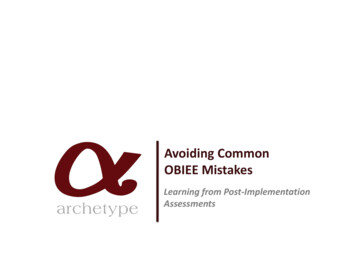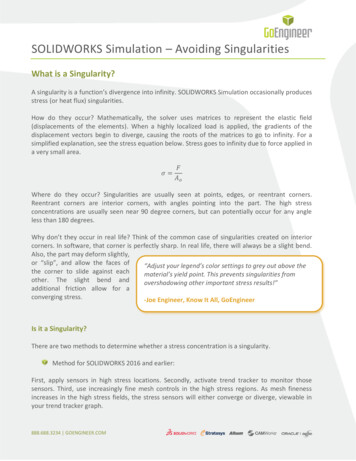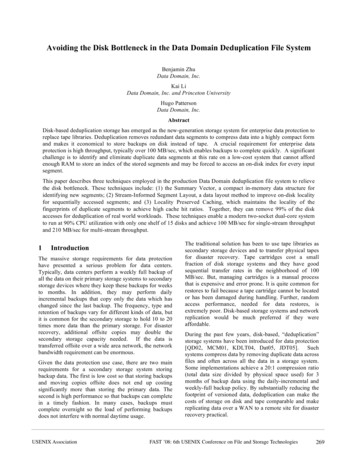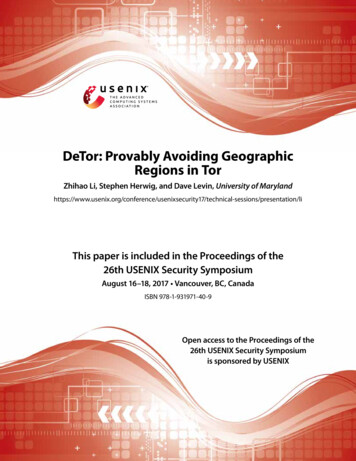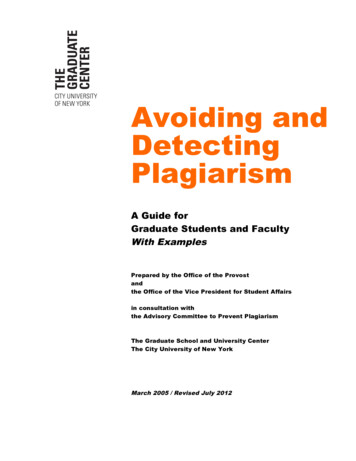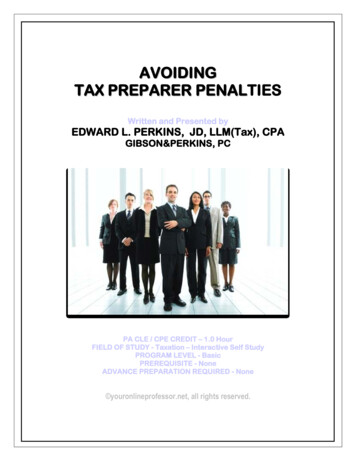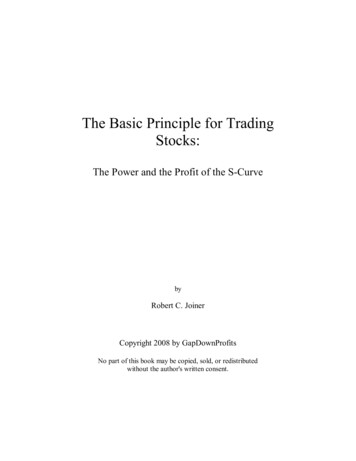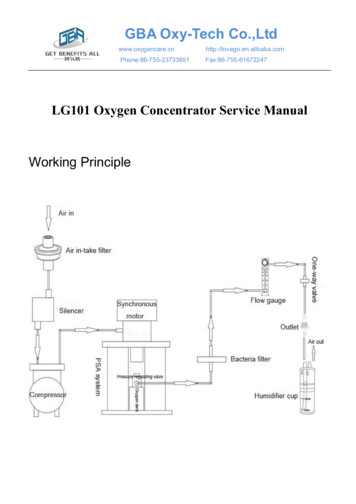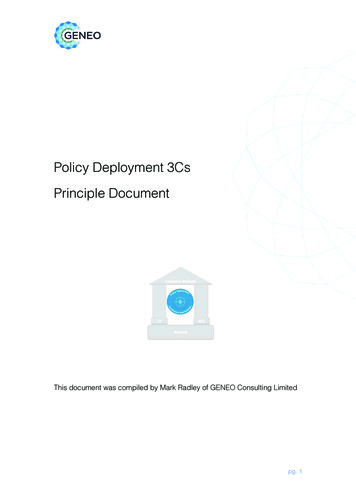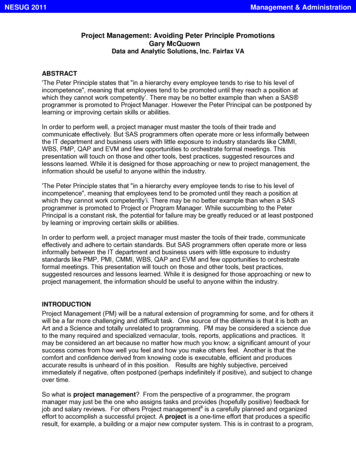
Transcription
NESUG 2011Management & AdministrationProject Management: Avoiding Peter Principle PromotionsGary McQuownData and Analytic Solutions, Inc. Fairfax VAABSTRACT'The Peter Principle states that "in a hierarchy every employee tends to rise to his level ofincompetence", meaning that employees tend to be promoted until they reach a position atwhich they cannot work competently‟. There may be no better example than when a SAS programmer is promoted to Project Manager. However the Peter Principal can be postponed bylearning or improving certain skills or abilities.In order to perform well, a project manager must master the tools of their trade andcommunicate effectively. But SAS programmers often operate more or less informally betweenthe IT department and business users with little exposure to industry standards like CMMI,WBS, PMP, QAP and EVM and few opportunities to orchestrate formal meetings. Thispresentation will touch on those and other tools, best practices, suggested resources andlessons learned. While it is designed for those approaching or new to project management, theinformation should be useful to anyone within the industry.'The Peter Principle states that "in a hierarchy every employee tends to rise to his level ofincompetence", meaning that employees tend to be promoted until they reach a position atwhich they cannot work competently‟i. There may be no better example than when a SASprogrammer is promoted to Project or Program Manager. While succumbing to the PeterPrincipal is a constant risk, the potential for failure may be greatly reduced or at least postponedby learning or improving certain skills or abilities.In order to perform well, a project manager must master the tools of their trade, communicateeffectively and adhere to certain standards. But SAS programmers often operate more or lessinformally between the IT department and business users with little exposure to industrystandards like PMP, PMI, CMMI, WBS, QAP and EVM and few opportunities to orchestrateformal meetings. This presentation will touch on those and other tools, best practices,suggested resources and lessons learned. While it is designed for those approaching or new toproject management, the information should be useful to anyone within the industry.INTRODUCTIONProject Management (PM) will be a natural extension of programming for some, and for others itwill be a far more challenging and difficult task. One source of the dilemma is that it is both anArt and a Science and totally unrelated to programming. PM may be considered a science dueto the many required and specialized vernacular, tools, reports, applications and practices. Itmay be considered an art because no matter how much you know; a significant amount of yoursuccess comes from how well you feel and how you make others feel. Another is that thecomfort and confidence derived from knowing code is executable, efficient and producesaccurate results is unheard of in this position. Results are highly subjective, perceivedimmediately if negative, often postponed (perhaps indefinitely if positive), and subject to changeover time.So what is project management? From the perspective of a programmer, the programmanager may just be the one who assigns tasks and provides (hopefully positive) feedback forjob and salary reviews. For others Project managementii is a carefully planned and organizedeffort to accomplish a successful project. A project is a one-time effort that produces a specificresult, for example, a building or a major new computer system. This is in contrast to a program,
NESUG 2011Management & Administrationwhich is 1) an ongoing process, such as a quality control program, or 2) an activity to manage aseries of multiple projects together.Project management includes developing a project plan, which includes defining and confirmingthe project goals and objectives, identifying tasks and how goals will be achieved, quantifyingthe resources needed, and determining budgets and timelines for completion. It also includesmanaging the implementation of the project plan, along with operating regular 'controls' toensure that there is accurate and objective information on 'performance' relative to the plan, andthe mechanisms to implement recovery actions where necessary.Projects usually follow major phases or stages (with various titles for these), including feasibility,definition, project planning, implementation, evaluation and support / maintenance. So whileProject Management is the “next step” for many programmers, it has very little to do with writingcode. The newly promoted programmer will find their responsibility, circle of communicationand required documentation rapidly expanding and their deliverables shifting to abstracts andestimates focusing on time, money and resources.When starting or expanding a career it is important to learn the vernacular or jargon. Some ofthe most common terms mentioned deal with project management certification (PMI, PMBOK,PMP, etc.). Others pertain to associated certifications for the company (CMMI 2 –CMMI 5) andyet more refer to the many expected tools, applications and types of reports that a manager isexpected to use and produce (WBS, GANT, QAP, RAP, EVM).The Program Manager‟s Book of Knowledge (PMBOK)iii by the Program Manager Institute (PMI)offers information on program management and certification after managing for various periodsof time. According to their website: “PMI‟s Project Management Professional (PMP) credentialis the most important industry-recognized certification for project managers. Globally recognizedand demanded, the PMP demonstrates that you have the experience, education andcompetency to successfully lead and direct projects. This recognition is seen throughincreased marketability to employers and higher salary; according to the PMI Salary Survey —Sixth Edition, a PMP increases your salary up to 10% more than your non-credentialedcolleagues and peers.”ivSo when referring to an individual a PMP is someone who has obtained a Project ManagementProfessional “PMP” certification from the PMI which tests the knowledge they consider essentialfor a manager. The test many be taken after completing the required hands on managementand relevant classes.Figure 1: PMP Question Domainsv2
NESUG 2011Management & AdministrationWhen referring to an object; PMP is the “Project Management Plan”. This is the single mostimportant document the PM will produces and is responsible for maintaining. The PMP isdesigned to clearly explain all areas and components of the project from multiple perspectives.The initial PMP represents what is expected; based upon what is known at the beginning of aproject. As the project moves through various stages and expends time and resources; thePMP and components must be updated and modified to reflect the new reality.The following is a table of contents from a generic template. vi Note that this single “generic”PMP document contains twenty other plans and related material. More complex PMP mustcontain additional plans for security, disaster recovery and other considerations.Figure 2 Project Management Plan3
NESUG 2011Management & AdministrationFor any plan, it is not uncommon to have multiple „artifacts” such as documents, forms, chartsand graphs. Various artifacts are used to document the constantly changing nature of a projectand to provide clarity to the “stakeholders” with access. Stakeholders are anyone and everyonethat has an impact on the project, or is impacted by the project and those with access would belisted in the Communication, Tracking and Reporting Plan.CMMIAn excellent source template for PM is the Capability Maturity Model Integration (CMMI).“CMMI defines practices that businesses have implemented on their way to success. Practicescover topics that include eliciting and managing requirements, decision making, measuringperformance, planning work, handling risks, and more. Using these practices, you can improveyour chances of business success. CMMI practices can be used in a team, a work group, aproject, a division, or an entire organization.”viiThe various CMMI levels are 1-5:1. Initial (chaotic, ad hoc, individual heroics) - the starting point for use of a new orundocumented repeat process.2. Repeatable - the process is at least documented sufficiently such that repeating thesame steps may be attempted.3. Defined - the process is defined/confirmed as a standard business process, anddecomposed to levels 0, 1 and 2 (the latter being Work Instructions).4. Managed - the process is quantitatively managed in accordance with agreed-uponmetrics.5. Optimizing - process management includes deliberate processoptimization/improvement.CMMI is a companywide certification that focuses on how processes are performed,documented, communicated and improved upon. The artifacts for CMMI overlap with the PMPand the two works very well together (as should be expected). Another reason for going afterthe CMMI certification is that many contracts for companies or governmental agencies require it.Even if not required; following CMMI practices should improve processes and will save time andeffort with documentation.TOOLS AND APPLICATIONSWhile the PM will not be writing much code, they will not be far from the PC. There are manytools and applications designed for project management and a new PM should take advantageof the many templates and forms available. While specialized tools are useful, many of themost common applications can mirror their functionality with a little effort.My applications of choice are now Microsoft Outlook, Project and Visio. Depending upon how itis used, Outlook may be the greatest assistant or obstacle to project management. If usedwell (many rules, folders, organized archives, groups, etc.), Outlook can provide a written,searchable and recoverable thread of correspondence and instructions. If not well organized,material will become unorganized and more of a burden than an asset.Microsoft Project and to some degree Microsoft Excel are used to keep track of resources andcommitments. Being able to switch between the two makes both more productive. MicrosoftProject has many “bells and whistles” but some find it difficult to work with. Excel is easy to useand almost always available, but lacks the pre-defined processes and reports that make Projectso desirable.4
NESUG 2011Management & AdministrationA primary use of Microsoft Project or Excel will be the Work Breakdown Structure (WBS) (seefigure 2). The WBS is a tool used to define and group a project‟s discrete work elements in away that helps organize and define the total work scope of the project.A work breakdown structure element may be a product, data, a service or any combination. AWBS also provides the necessary framework for detailed cost estimating and control along withproviding guidance for schedule development and control. Additionally the WBS is a dynamictool and can be revised and updated as needed by the project manager.viiiFigure 3 Work Breakdown StructureNON TECHNICALBesides the technical, Project Management requires a paradigm shift and many non-technicalskills with Analysis, Communication, Budgeting, Teamwork, Intelligence, Calmness and TimeManagement considered the most essentialix. The paradigm shift is represented by the use of“We” rather than “I”, but it includes much more. The programmer who was once responsible foronly their own work is now responsible for the work effort and business practices of everyonewho works on the project. To some degree they are also responsible for any and all factors thatmay affect the project; because they are responsible for mitigating risks. While projectmanagement may bestow a certain degree of authority upon an individual; the authority istypically bundled with even greater responsibility.5
NESUG 2011Management & AdministrationAnalysis, Teamwork and Intelligence are traits every successful programmer should have.Although present, they will be used very differently than before and can always be improvedupon. Programmers should also be skilled in communication, but the level required of a PM willbe both higher within the organization and broader to include other departments, companies oragencies. For many PM the enhanced communications requires formal documents andpresentations to explain the project to key stakeholders, or to justify the associated resourcesand expenses.Resources and expenses are all part of budgeting and will be a major complication for most newPM. The three key stages to a budget are preparing it, writing it and monitoring it. Whilst yourfinance department may well be ostensibly charged with doing these things for you – as projectmanager you have the ultimate responsibility for the budget and need to be able to understandwhat you are being told about the budget. Unless your own background is in accounting you willfeel obliged to accept what you‟re told, if you don‟t take the time to learn some basic budgetingskills. You will need these as at time you will need to know how to rationally and logicallychallenge budget over-runs that you become aware of as well as be able to sensibly monitor thebudget as the project progressesx. Budgeting is also very emotional as programmers andformer coworkers become “resources” to assign and monitor.Calmness may also be a significant challenge for a new PM. While programming under timeconstraints and other issues can be frustrating; most programmers will not be prepared for theoften negative social and political interactions and the consequences they present. Regardlessof the situation, a PM must be able to move on from a setback in an orderly manner to solve theproblem or to rectify the situation.CONCLUSIONTo transition into a program manager without becoming a cliché; a programmer needs to devotesufficient time, effort and understanding to develop the essential skills and abilities. This doesnot guarantee success, but it should make the Peter
increased marketability to employers and higher salary; according to the PMI Salary Survey — Sixth Edition, a PMP increases your salary up to 10% more than your non-credentialed colleagues and peers.”iv So when referring to an individual a PMP is someone who has obtained a Project Management

